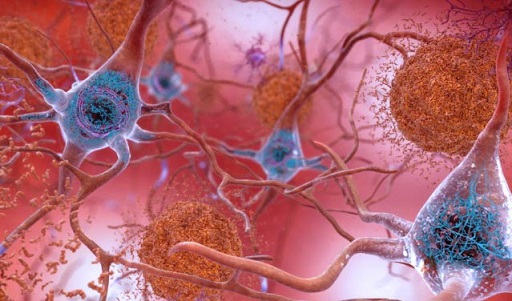BREAKING! German study finds that not only neurons but certain glial cells in the brain also produce Amyloid Beta!
Nikhil Prasad Fact checked by:Thailand Medical News Team Aug 18, 2024 7 months, 2 weeks, 4 hours, 45 minutes ago
Alzheimer News: Alzheimer’s disease is one of the most significant health challenges of our time, impacting over 35 million people worldwide. For decades, research has focused primarily on neurons as the main contributors to the formation of amyloid beta plaques in the brain, a hallmark of Alzheimer’s disease. However, a groundbreaking study conducted by researchers at the Max Planck Institute for Multidisciplinary Sciences in Göttingen, Germany, has revealed that neurons are not the sole producers of amyloid beta - certain glial cells in the brain, specifically oligodendrocytes, are also involved. This discovery could open up new therapeutic avenues to treat or slow the progression of Alzheimer’s disease.
 Study finds that not only neurons but certain glial cells in the brain also produce Amyloid Beta
New Understanding of Amyloid Beta Production
Study finds that not only neurons but certain glial cells in the brain also produce Amyloid Beta
New Understanding of Amyloid Beta Production
The study sheds new light on the role of glial cells in Alzheimer’s disease. This
Alzheimer News report explores these significant findings that challenge the traditional understanding of amyloid beta production in the brain. The researchers discovered that oligodendrocytes, a type of glial cell, produce amyloid beta, contributing to plaque formation in the brains of Alzheimer’s patients. This revelation not only broadens our understanding of the disease but also suggests new targets for treatment.
Neurons have long been thought to be the primary source of amyloid beta, and thus the main target for Alzheimer’s therapies. However, this new research indicates that the role of glial cells in the development of Alzheimer’s disease may have been underestimated. Oligodendrocytes are responsible for forming myelin, the protective sheath that insulates nerve fibers and ensures the efficient transmission of electrical signals in the brain. The study found that these cells also produce amyloid beta, which is then incorporated into the plaques that are characteristic of Alzheimer’s disease.
The Mechanism Behind Amyloid Beta Production
To understand how amyloid beta is produced, it is essential to examine the role of the enzyme BACE1. Both neurons and oligodendrocytes produce amyloid beta by cleaving a larger precursor molecule with the help of this enzyme. The researchers conducted experiments where they specifically knocked out the BACE1 enzyme in the neurons and oligodendrocytes of mice. Using advanced 3D light-sheet microscopy, they were able to observe the formation of plaques throughout the brain, providing a comprehensive view of amyloid plaque distribution.
The results were striking. When BACE1 was knocked out in neurons, plaque formation was reduced by over 95%. However, when BACE1 was knocked out in oligodendrocytes, plaque formation was reduced by approximately 30%. This suggests that while neurons are indeed the primary producers of amyloid beta, oligodendrocytes also play a significant role. The study highlights the importance of amyloid beta production in these glial cells, showing that they contribute
to the formation of plaques when a certain threshold of neuronal amyloid beta is present.
The Role of Glial Cells in Alzheimer’s Disease
The discovery that oligodendrocytes produce amyloid beta adds a new layer of complexity to our understanding of Alzheimer’s disease. It raises important questions about the role of glial cells in the brain and how they contribute to the development and progression of neurodegenerative diseases. Glial cells, which include oligodendrocytes, astrocytes, and microglia, have traditionally been viewed as supporting cells that provide structural and metabolic support to neurons. However, this study suggests that their role may be more active and direct, particularly in the context of Alzheimer’s disease.
The researchers also found that when amyloid beta production is reduced in oligodendrocytes, there is a corresponding decrease in plaque formation, although not to the same extent as when production is reduced in neurons. This finding underscores the importance of both cell types in the disease process and suggests that a multi-targeted approach to treatment may be necessary.
Implications for Alzheimer’s Therapies
The findings of this study have significant implications for the development of new treatments for Alzheimer’s disease. Currently, therapies targeting amyloid beta production focus primarily on neurons. However, the discovery that oligodendrocytes also contribute to plaque formation suggests that these glial cells could be another target for therapeutic intervention. Inhibiting the production of amyloid beta in oligodendrocytes could potentially slow the progression of the disease.
One of the key takeaways from the study is the concept of a threshold level of amyloid beta required for plaque formation. The researchers suggest that if BACE1 can be inhibited before this threshold is reached, it may be possible to delay the onset of plaque formation and, consequently, the progression of Alzheimer’s disease. This approach could be particularly useful in the early stages of the disease, where interventions may be more effective.
Future Directions and Conclusion
This study opens up several new avenues for research and potential therapies. By targeting both neurons and oligodendrocytes, it may be possible to develop more effective treatments for Alzheimer’s disease that address the disease’s underlying mechanisms more comprehensively. Additionally, understanding the precise role of glial cells in amyloid beta production and plaque formation could lead to new strategies for preventing or slowing the progression of Alzheimer’s disease.
In conclusion, the discovery that oligodendrocytes, in addition to neurons, produce amyloid beta represents a significant shift in our understanding of Alzheimer’s disease. This new insight could pave the way for novel therapeutic approaches that target not only neurons but also glial cells. By expanding the focus of research to include these previously overlooked cells, scientists may be able to develop more effective treatments for this devastating disease.
The study findings were published in the peer-reviewed journal: Nature Neuroscience.
https://www.nature.com/articles/s41593-024-01730-3
For the latest
Alzheimer News, keep on logging to Thailand Medical News.
Read Also:
https://www.thailandmedical.news/news/new-study-reveals-link-between-high-fat-diet-and-alzheimer-s-disease
https://www.thailandmedical.news/news/essential-oil-from-dalbergia-pinnata-shows-promise-in-treating-alzheimer-s-disease
